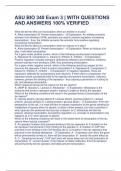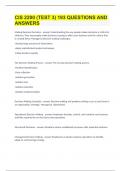ASU BIO 340 Exam 3 | WITH QUESTIONS AND ANSWERS 100% VERIFIED What will be the effect on transcription when an inhibitor is in play? A. Allow transcription B. Prevent transcription - B Explanation: An inhibito r prevents activator from binding to DNA; activators are used in positive regulation (increasing transcription) - thus, the inhibitor prevents the activator from positive regulating (increasing) transcription. What will be the effect on transcription when an inducer is in play? A. Allow transcription B. Prevent transcription - A Explanation: When an inducer is in play, it will allow transcription. For a gene under positive control, which of the following would prevent transcription? A. Repressor B. Corep ressor C. Inducer D. Effector E. Inhibitor - E Explanation: Positive regulation includes activators (affected by effectors and inhibitors); inhibitors prevent activator from binding to DNA, thus preventing transcription. For a gene under negative control, which of the following would you expect to find bound to the repressor if there is active transcription? A. Repressor B. Corepressor C. Inducer D. Effector E. Inhibitor - C Explanation: In negative regulation, there are repressors (affected by correpress ors and inducers). If there were a corepressor, the repressor would successfully bind to the operator and prevent transcription. Inducers, however, prevent the binding of the repressor - thus causing a prevention of it doing its job, and allowing transcrip tion. Which molecule serves as the inducer for the lac operon? A. cAMP B. Glucose C. Lactose D. Allolactose - D Explanation: Allolactose is the molecule that binds to repressor protein, making it unable to bind to the operator. Which of the following conditions will result in the greatest levels of transcription of the lac operon? A. Lactose absent, glucose absent B. Lactose absent, glucose present C. Lactose present, glucose present D. Lactose present, glucose absen - D Explan ation: From the perspective of the cell, it is most efficient to repress expression of the genes allowing for metabolism of lactose when it's absent, to allow it when present, but only to prioritize it when glucose (the preferred food source) is absent. In C, allolactose will also be present, allowing transcription, but positive regulation (i.e. increase in transcription) only happens as in D, when glucose is absent. Which of the following mutations will result in the lowest level of transcription of the la c operon when lactose is present? A. An operator mutation that prevents binding of the lac repressor B. A mutation in the lac repressor that prevents it from binding to the operator C. A mutation in CAP that prevents it from binding to the CAP binding sit e D. A mutation in the lac repressor that prevents it from binding allolactose - D Explanation: A - if repressor can't bind, the gene will be permanently turned on, there will be transcription. B - exactly the same effect as A. C - "tempting but wrong"; C AP can't bind, will cause lower but not total prevention of transcription. D - correct answer; if the inducer is totally ineffective, then the repressor will permanently bind to operator and totally prevent transcription. The regulatory elements in the lac operon act to: A. Repress transcription when there is no lactose present B. Repress transcription when there is lactose present C. Activate transcription when there is no glucose present D. Activate transcription when there is glucose present E. A and C - E Explanation: The cell wants to both repress transcription when there is no lactose present and activate it when glucose is absent (C "slightly less good" answer than A, but still true). Similar to Clicker Question 6 A bacterium needs to make a certain lipid that it cannot obtain from its environment. That same lipid is involved in regulating the expression of the enzymes that make it. Which of the following is the most likely regulatory function of the lipid? A. Effector B. Activator C. Inducer D. Co -repressor E. Operator - D Explanation: If you have that lipid, you would want it to not make any more. So, if you have the lipid in the cell, you would want to turn off the transcription, so it would likely be involved in negative regulation. Effectors an d activators are both involved in positive regulation. An inducer is under negative regulation but its job is to turn on transcription. A co -repressor will only turn the gene off if there is a signal the cell can sense. Operator is a piece of DNA. A bacter ium is unable to transport lactose into the cell to be broken down. Which gene is likely mutated in this bacterium? A. lacZ B. lacY C. lacI D. lacP E. lacO - B Explanation: If you can't transport lactose, then it means permease isn't working. So lacY is likely mutated since that is the gene that encodes permease. Under which conditions will E. coli make the least amount of beta -galactosidase? A. I+ O+ Z+, glucose absent, lactose present B. Is Oc Z+, glucose present, lactose absent C. I - O+ Z+, glucose ab sent, lactose absent D. Is O+ Z+, glucose absent, lactose present - D Explanation: A is wild type, so the expression level would be high, B has a super repressor, meaning is not able to bind allolactose, but since we have constitutive operators, the gene is going to turn "on". For C, the repressor can't bind the operator, so the gene will not undergo negative regulation. For D, the super repressor bound to the wild -type operator will keep the gene off no matter what, even though lactose is present. In term s of lac operon regulation, what happens when an I+, O+, P+, Z - mutant E. coli is grown in medium containing very low glucose and high lactose? A. CAP is bound to the DNA but the lac repressor is not, E. coli grows B. CAP is bound to the DNA but the lac r epressor is not, E. coli does not grow C. Lac repressor is bound to the DNA but CAP is not, E. coli grows D. Lac repressor is bound to the DNA but CAP is not, E. coli does not grow E. Both CAP and lac repressor are bound to DNA, E. coli does not grow - E Explanation: Three parts, think about whether CAP is bound, Lac repressor is bound, and does the cell grow. In this case, the regulation is normal, but there is no β -gal. No β -gal means that allolactose can not be made, so the lac repressor is always bound . There is low glucose, so cAMP is being made and CAP will bind the DNA (this is independent of the lac operon function). Since lactose can't be used and there is low glucose, the e.coli will not grow. Which of the following tends to loosen the interaction between DNA and histones? A. Acetylation of histone tails B. Deacetylation of histone tails - A. Acetylation of histone tails





